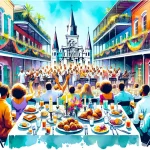New Orleans brims with rich cultural traditions, and one of the most cherished is the Reveillon dinner. This festive culinary experience traces its roots back to the early 19th century and has become an integral part of the city’s holiday celebrations.
In This Article
TL;DR
- Reveillon dinners originated as lavish feasts following midnight mass on Christmas Eve, marking the end of the Advent fasting period for Creole families.
- These multi-course meals typically feature decadent Creole and French dishes like gumbo, turtle soup, daube glacé (jellied beef stew), and an array of seafood, meat, and dessert offerings.
- Reveillon dinners showcase the unique cultural blend of New Orleans, combining French, Spanish, African, and Native American influences into a truly distinctive culinary experience.
Historical Context of Reveillon Dinners
The Reveillon tradition has its roots in the French Catholic practice of attending midnight mass on Christmas Eve, known as the Réveillon (French for “awakening”). After the long night of worship and fasting, families would gather for an elaborate feast to celebrate the birth of Christ and break their fast.
As the tradition took hold in New Orleans, the Creole population embraced and adapted it, infusing the Reveillon with their own unique cultural influences. What began as simple family gatherings evolved into lavish culinary events, showcasing the city’s diverse heritage and culinary prowess.
Over the years, the Reveillon dinner tradition waxed and waned, influenced by social and cultural changes. In the 1990s, however, a concerted effort by local organizations and restaurants revived the Reveillon, solidifying its place as a beloved holiday tradition in New Orleans.
The Culinary Experience of Reveillon Dinners
A Reveillon dinner is a true feast for the senses, with each course showcasing the rich flavors and techniques of Creole cuisine. Typical menus feature a variety of dishes, often including:
- Gumbo or turtle soup as a starter
- Seafood courses like oysters, shrimp, or crab
- Meat dishes like daube glacé (jellied beef stew) or veal grillades
- Decadent desserts like bread pudding or king cake
Local ingredients like Gulf seafood, Creole spices, and seasonal produce are heavily featured, reflecting the city’s connection to its surrounding environment.
Prominent chefs like Emeril Lagasse, John Besh, and Susan Spicer have played a significant role in shaping and elevating the Reveillon tradition, putting their unique spin on classic dishes while honoring the city’s culinary heritage.
The Setting: Where Reveillon Dinners Take Place
Reveillon dinners are hosted at some of New Orleans’ most iconic and historic restaurants, many of which have been serving these feasts for decades. Venues like Antoine’s, Galatoire’s, and Arnaud’s provide the perfect ambiance for a Reveillon experience, with their elegant decor, white-linen tablecloths, and impeccable service.
The location of these restaurants is also an integral part of the Reveillon tradition. Many are situated in the French Quarter, allowing diners to soak in the festive atmosphere of the city’s most famous neighborhood, adorned with twinkling lights and holiday decorations.
Timing and Seasonality of Reveillon Dinners
Reveillon dinners are inextricably linked to the Christmas season in New Orleans. While the original tradition centered around Christmas Eve, modern Reveillon dinners are typically offered throughout the month of December, allowing more opportunities for locals and visitors alike to partake in the experience.
The timing of these dinners is not only practical but also symbolic, as they coincide with the city’s peak holiday season. The festive atmosphere and cooler weather make Reveillon dinners all the more enjoyable, providing a cozy respite from the hustle and bustle of the season.
Cultural Significance and Community Impact
Beyond their culinary delights, Reveillon dinners hold deep cultural significance for New Orleans. They serve as a celebration of the city’s diverse heritage, blending French, Spanish, African, and Native American influences into a truly unique culinary tradition.
These dinners also foster a sense of community and togetherness, bringing families and friends together to share in the joy of the holiday season. For many locals, attending a Reveillon dinner is an annual ritual, a way to connect with their roots and pass on traditions to younger generations.
Furthermore, Reveillon dinners contribute significantly to the local economy and tourism industry. Visitors from around the world flock to New Orleans during the holiday season, drawn by the allure of these festive feasts and the city’s vibrant culture.
Practical Guide to Experiencing a Reveillon Dinner
To experience a Reveillon dinner in New Orleans, advanced planning is essential. Many of the city’s top restaurants offer these special menus, and reservations fill up quickly during the holiday season.
When booking, be prepared to select from a prix fixe menu, typically ranging from $50 to $100 per person, depending on the venue and number of courses. Some restaurants also offer wine pairings or specialty cocktails to complement the meal.
Dress codes vary, but most Reveillon dinners call for smart casual or semi-formal attire, allowing diners to embrace the festive spirit while remaining comfortable.
To enhance the experience, consider arriving early to explore the surrounding neighborhood or indulge in a pre-dinner cocktail at the restaurant’s bar. And, of course, come with an appetite – these multi-course feasts are not for the faint of heart!
Comparison with Other Cultural Dining Traditions
While Reveillon dinners are unique to New Orleans, they share similarities with other cultural dining traditions around the world. For example, the Spanish celebration of Nochebuena (Christmas Eve) also involves a grand feast after midnight mass, often featuring dishes like roast suckling pig and seafood stews.
In Italy, the Feast of the Seven Fishes is a Christmas Eve tradition, where families gather to enjoy a multi-course seafood extravaganza. And in Poland, the Wigilia (Christmas Eve vigil) features a meatless feast with dishes like pierogi, borscht, and poppy seed rolls.
What sets Reveillon dinners apart is their distinctly Creole flair, reflecting the unique cultural melting pot that is New Orleans. These dinners are not just about the food; they are a celebration of the city’s rich history, resilience, and joie de vivre.
As you immerse yourself in the sights, sounds, and flavors of a Reveillon dinner, you’ll understand why this tradition has endured for centuries – and why it continues to captivate locals and visitors alike, year after year.






